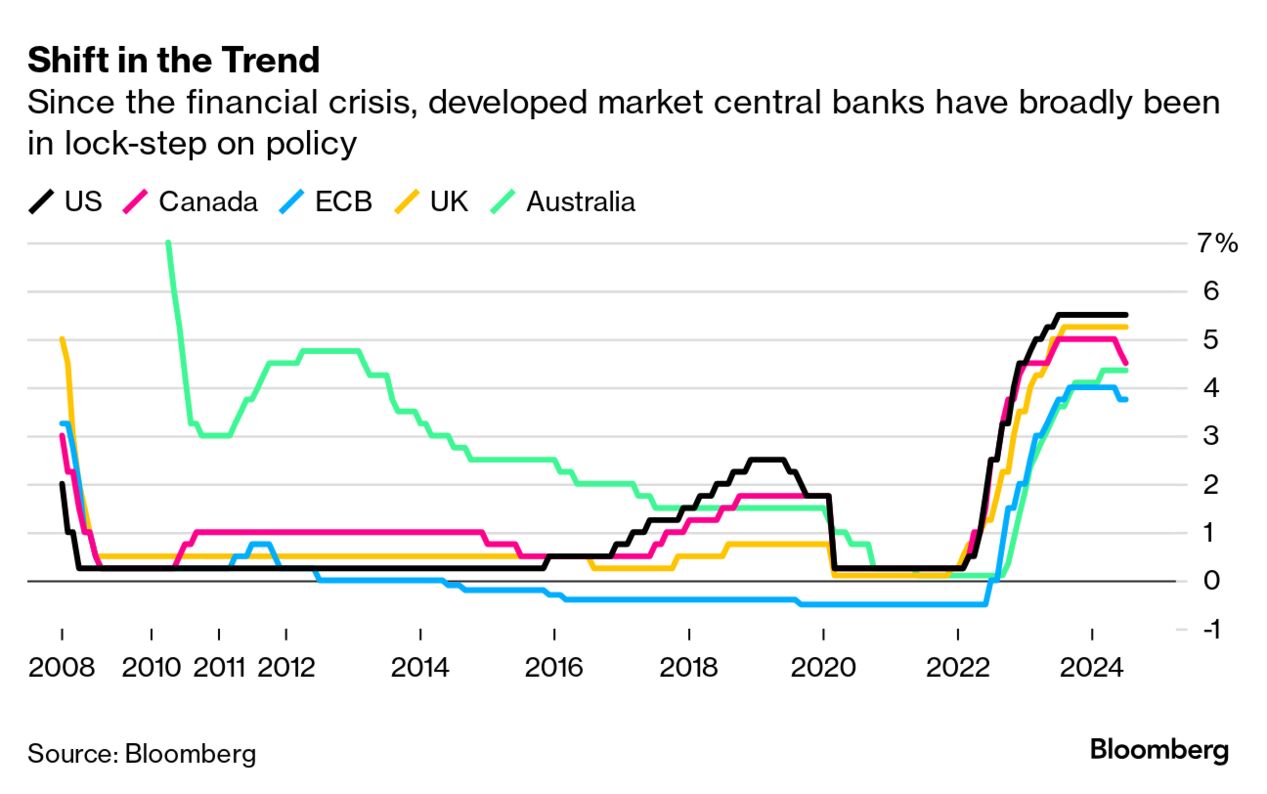The era of global central banks moving in lockstep with the Federal Reserve is over. For decades, the Fed dictated the world’s monetary policy. Its interest rate changes affected currencies, stock indices, and economies worldwide.
If the Fed raised rates, everyone else had to follow, or their currencies would take a beating. But in today’s fragmented global economy, things are different.
Countries have their own battles, and many central banks are now making moves based on their local needs, not what happens in Washington.
Central banks taking their own path
In the 1990s and 2000s, it was all about the Fed. US economic power was at its peak, and most central banks danced to its tune.
Wall Street’s stock markets set the rhythm, and if you didn’t keep up, your currency could collapse. US allies enjoyed the benefits of access to American markets and investments.
Meanwhile, adversaries like the Soviet Union, which crumbled under sanctions, saw their economies wither. China, still a friend back then, experienced massive growth. But that’s all in the past.
Fast forward to today, and the world is a very different place. Every major economy is facing unique challenges. In the US, inflation has been the big problem for two years.
Europe, dealing with the fallout from Russia’s war in Ukraine, is struggling with inflation too, made worse by the loss of cheap Russian gas.
Japan, though, is happy to see inflation after decades of economic stagnation. And China? It’s dealing with deflation and a collapsing property market.
So as the Fed struggles to contain inflation, other central banks are doing their own thing. The European Central Bank and the Bank of England acted earlier and started cutting rates before the Fed even made its first move.
And Japan’s yen has been on a rollercoaster. It tanked early in the year, shot up over the summer, and then dropped again as the Fed and the Bank of Japan made different decisions.
The volatility has been wild, with massive effects on the yen carry trade that has messed with everything from US stocks to Bitcoin, causing chaos in global markets.
The Fed’s waning influence
US foreign policy, especially on Russia, isn’t packing the same punch. In 2022, the Biden administration threw sanctions at Vlad Putin, trying to cripple his economy.
But that didn’t work. India kept buying Russian oil, China kept selling goods to Moscow, and North Korea sent artillery shells to fuel Putin’s war.
Now Russia is cruising towards a solid 3.5% economic growth in 2024, and its troops are still making advances in Ukraine.
What’s changed? For one, the US and its allies now hold a smaller share of the global economy. Back in 1990, the US held 21% of the global GDP, and the G7 made up 50%. By 2024, the US share has dropped to 15%, and the G7 is down to 30%.
The G7 used to be where the big decisions were made. That changed when the G20 came onto the scene, bringing in China and other emerging powers.
But even the G20 is now fractured, with deep divisions between the West and countries like China and Russia. And then of course, the rise of competing groups.
The dollar, while still dominant, is losing its iron grip. Back in 2000, the greenback made up 72% of global central bank reserves.
By 2023, that had dropped to 58%. China, which now settles a quarter of its trade in yuan, is chipping away at the dollar’s dominance. Ten years ago, that number was zero. The winds are clearly changing.
The result? The US’s gravitational pull on the global economy has weakened. China, not the Fed, might be the real force shaping global growth in the near future.
Effects on markets and investors
This decoupling of central bank policies is shaking things up for governments, businesses, and investors worldwide.
Supply chains, trade partnerships, and financial markets are all feeling the effects of central banks no longer moving in sync.
Companies must tread carefully, choosing where to source and where to sell with precision. The smallest missteps can lead to being hit by tariffs, sanctions, or shrinking demand.
For investors, the stakes are even higher, and the gains or losses come fast. The British pound surged and then crashed within weeks as the Bank of England got out of sync with the Fed.
China’s stock markets, which took a beating throughout 2023, managed to claw back a year’s worth of losses in just a few days, all thanks to Beijing’s stimulus push.
Oil prices spiked by $10 a barrel, hitting $80 in October, as war in the Middle East escalated. But at the end of the day, looks like it’s every central bank for itself.





